- Books Name
- ABCD CLASSES Mathematics Book
- Publication
- ABCD CLASSES
- Course
- CBSE Class 9
- Subject
- Mathmatics
Construction
In Constructions class 9 chapter 11, explains how different shapes are drawn using the compass and ruler. In this chapter, you can learn how to construct the bisector of the given angle, construction of a perpendicular bisector of the given line segment is explained with construction steps and a clear diagram. Also, solve all the important questions for class 9 Maths Chapter 11 construction problems given in the textbook to score good marks.
Constructions Class 9 Concepts
The important topics and subtopics covered under constructions class 9 are:
- Introduction
- Basic constructions
- Some constructions of triangles
- Summary
Construction Class 9 Notes
For constructing the angle bisector of angle ABC, take B as a center and construct an arc (any radius) intersecting the rays BA and BC at D and E. Now take E and D as centers and a radius of more than ½ DE, construct arcs such that they intersect with each other at F.
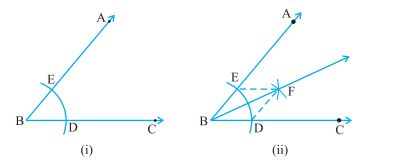
Join BF. This line is the required angle bisector of the given angle ABC.
Proof: Join EF and DF. Now, from triangle BEF and triangle BDF, BD = BE (Radius of the same arc), DF = EF (Arcs of equal radii) and BF are Common. Therefore, triangle BEF is congruent to triangle BDF by SSS congruence rule. Hence by CPCT, angle EBF is equal to angle DBF.
Constructions Class 9 Example
Go through the below example:
Example: Given that AB is a line segment. Construct the perpendicular bisector for the given line segment.
Construction Steps:
- Take A and B as centers and the radius should be more than 1/2 AB. Now, draw arcs on both sides of the line segment AB (the arc should intersect each other)
- Assume that these arcs intersect each other at the points P and Q, and join the points PQ
- Now, PQ intersect AB at the point M. Therefore, the line PMQ is the required perpendicular bisector of AB
Now, let us see how this method gives us the perpendicular bisector of AB.
To prove this, join A and B to both P and Q to form AP, AQ, BP and BQ.
From the triangles PAQ and PBQ
AP = BP and AQ = BQ (Arcs of equal radii)
PQ = PQ (Common)
Therefore, by using SSS Rule, ∆ PAQ ≅ ∆ PBQ
Thus, ∠ APM = ∠ BPM (CPCT)
Now in the triangles PMA and PMB,
AP = BP
PM = PM (Common)
∠ APM = ∠ BPM
Thus by using SAS rule, we get ∆ PMA ≅ ∆ PMB
Hence, by using CPCT, AM = BM and ∠ PMA = ∠ PMB
From the linear pair axiom ∠ PMA + ∠ PMB = 180°
∠ PMA = ∠ PMB = 90°
Therefore, the line PM, that is, PMQ is the perpendicular bisector of the line segment AB.
Practice Problems
Solve the practical problems given below for constructions class 9:
- Construct an angle of 45° at the initial point of a given ray. And also, justify the construction.
- Construct a triangle ABC in which ∠B = 30°, ∠C = 90° and AB + BC+ CA = 11 cm.
- Construct a triangle XYZ in which YZ = 8cm, ∠Y = 45° and XY – XZ= 3.5 cm
- Construct the angle 105°, and verify that using the protractor.
Basic Constructions
Why do we learn constructions? Suppose a building needs to be constructed. One needs to know the accurate map of the building. Construction means drawing the lines and angles accurately. Also to draw the road maps, learning the basic constructions is of great importance. Let us now learn about the basic constructions in geometry.
Suggested Videos
Construction of segment of a circle
Some Constructions of Triangles I
Construct a perpendicular bisector of a line segment
Basic Constructions
1. Construction of a bisector of a given angle
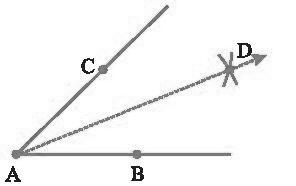
Construction:
- With A as a center and using compasses, draw an arc that cuts both rays of A.
- Label the points of intersection as B and C.
- Now with B as a center, draw (in the interior of A) an arc whose radius is more than half the length BC.
- With the same radius and with C as a center, draw another arc in the interior of A.
- Let the two arcs intersect at D
- So we get AD as the required bisector of A.
2. Construction of the perpendicular bisector of a given line segment.
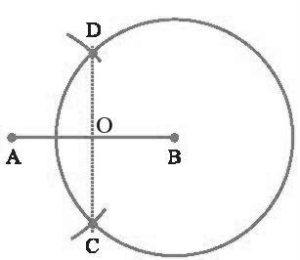
Construction:
- Draw a line segment AB
- Now take A as a center, use compasses, and draw a circle.
- The radius of your circle should be more than half the length of AB.
- With the same radius and with B as a center, draw another circle using compasses.
- Let it cut the previous circle at C and D.
- Join CD so it cuts AB at O.
- O is the midpoint of AB. Also, COA and COB are at right angles.
- Therefore, the CD is the perpendicular bisector of AB.
3. Construction of 60° Angle
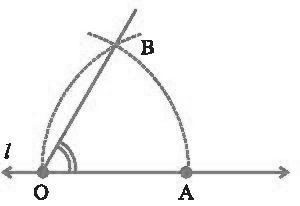
Construction:
- Take a ruler and draw a line l and make a point O on it. Take a compass and put its one end at point O and draw an arc with any convenient radius.
- We take the center O and draw an arc. We get to point A.
- Now take the compass and with the same orientation taking the point A as the center draw an arc that passes through O. Draw an arc such that it intersects the existing arc.
- Here OA and OB are nothing but the radius which is equal in length.
- So actually we are trying to draw an equilateral triangle which means the angle we see in the above construction is 60 degrees.
- We get ∠BOA which measures 60 degrees.
Solved Examples for You on Basic Constructions
Question 1: To construct a perpendicular to a line L from a point P outside the line, steps are given in the jumbled form. Identify the second step from the following.
1) Draw line PQ
2) Draw a line L and consider point P outside the line.
3) Take P as a center, draw 2 arcs on line L and name it as points A and B respectively.
4) Taking A and B as a center one by one and keeping the same distance in compass, draw the arcs on another side of the plane. The point where these arcs intersect name that point as Q
- 4
- 3
- 2
- 1
Solution: B is the correct option. 3 is the second step amongst all.
Question 2: While constructing a parallel line to a given line, we ______.
- Copy a segment
- Bisect a segment
- Copy an angle
- Construct a perpendicular
Solution: C is the correct option. While constructing a parallel line to a given line, we copy an angle.
Chapter 11 - Construction
In Constructions class 9 chapter 11, explains how different shapes are drawn using the compass and ruler. In this chapter, you can learn how to construct the bisector of the given angle, construction of a perpendicular bisector of the given line segment are explained with construction steps and clear diagram. Also, solve all the important questions for class 9 Maths Chapter 11 construction problems given in the textbook to score good marks.
Constructions Class 9 Concepts
The important topics and subtopics covered under constructions class 9 are:
- Introduction
- Basic constructions
- Some constructions of triangles
- Summary
Construction Class 9 Notes
For constructing the angle bisector of angle ABC, take B as a centre construct an arc (any radius) intersecting the rays BA and BC at D and E. Now take E and D as centres and radius more than ½ DE, construct arcs such that they intersect with each other at F.
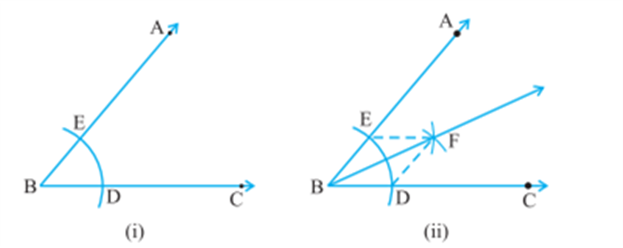
Join BF. This line is the required angle bisector of given angle ABC.
Proof:
Join EF and DF. Now, from triangle BEF and triangle BDF, BD = BE (Radius of the same arc), DF = EF (Arcs of equal radii) and BF is Common. Therefore, triangle BEF is congruent to triangle BDF by SSS congruence rule. Hence by CPCT, angle EBF is equal to angle DBF.
Constructions Class 9 Example
Go through the below example:
Example:
Given that AB is a line segment. Construct the perpendicular bisector for the given line segment.
Construction Steps:
- Take A and B as centres and radius should be more than 1/2 AB. Now, draw arcs on both sides of the line segment AB (the arc should intersect each other)
- Assume that these arcs intersect each other at the points P and Q, and join the points PQ
- Now, PQ intersect AB at the point M. Therefore, the line PMQ is the required perpendicular bisector of AB
Now, let us see how this method gives us the perpendicular bisector of AB.
To prove this, join A and B to both P and Q to form AP, AQ, BP and BQ.
From the triangles PAQ and PBQ
AP = BP and AQ = BQ (Arcs of equal radii)
PQ = PQ (Common)
Therefore, by using SSS Rule, ∆ PAQ ≅ ∆ PBQ
Thus, ∠ APM = ∠ BPM (CPCT)
Now in the triangles PMA and PMB,
AP = BP
PM = PM (Common)
∠ APM = ∠ BPM
Thus by using SAS rule, we get ∆ PMA ≅ ∆ PMB
Hence, by using CPCT, AM = BM and ∠ PMA = ∠ PMB
From the linear pair axiom ∠ PMA + ∠ PMB = 180°
∠ PMA = ∠ PMB = 90°
Therefore, the line PM, that is, PMQ is the perpendicular bisector of the line segment AB.
Practice Problems
Solve the practical problems given below for constructions class 9:
- Construct an angle of 45° at the initial point of a given ray. And also, justify the construction.
- Construct a triangle ABC in which ∠B = 30°, ∠C = 90° and AB + BC+ CA = 11 cm.
- Construct a triangle XYZ in which YZ = 8cm, ∠Y = 45° and XY – XZ= 3.5 cm
- Construct the angle 105°, and verify that using the protractor.
Basic Constructions
Why do we learn constructions? Suppose a building needs to be constructed. One needs to know the accurate map of the building. Construction means to draw the lines and angles accurately. Also to draw the road maps, learning the basic constructions is of great importance. Let us now learn about the basic constructions in geometry.
Suggested Videos
Construction of segment of circle
Some Constructions of Triangles I
Construct perpendicular bisector of a line segment
Basic Constructions
1. Construction of a bisector of a given angle
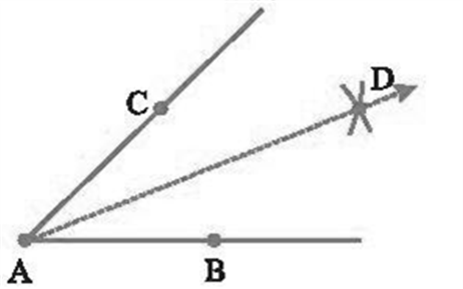
Construction:
- With A as a centre and using compasses, draw an arc that cuts both rays of A.
- Label the points of intersection as B and C.
- Now with B as a centre, draw (in the interior of A) an arc whose radius is more than half the length BC.
- With the same radius and with C as a centre, draw another arc in the interior of A.
- Let the two arcs intersect at D
- So we get AD as the required bisector of A.
2. Construction of the perpendicular bisector of a given line segment.
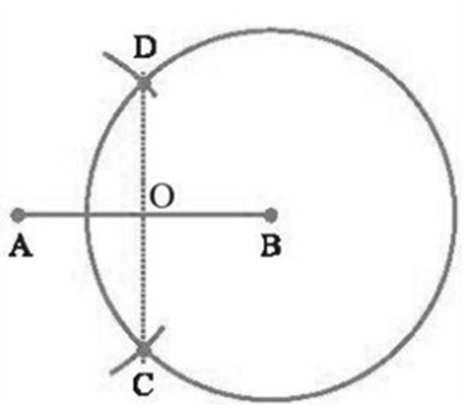
Construction:
- Draw a line segment AB
- Now take A as a centre, using compasses, draw a circle.
- The radius of your circle should be more than half the length of AB.
- With the same radius and with B as a centre, draw another circle using compasses.
- Let it cut the previous circle at C and D.
- Join CD so it cuts AB at O.
- O is the midpoint of AB. Also, COA and COB are right angles.
- Therefore, the CD is the perpendicular bisector of AB.
3. Construction of 60° Angle
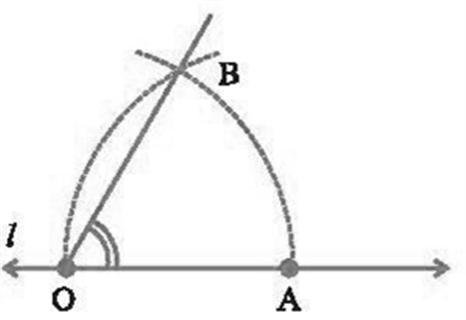
Construction:
- Take a ruler and draw a line l and make a point O on it. Take a compass and put its one end at point O and draw an arc with any convenient radius.
- We take the centre O and draw an arc. We get the point A.
- Now take the compass and with the same orientation taking the point A as the centre draw an arc that passes through O. Draw an arc such that it intersects the existing arc.
- Here OA and OB are nothing but the radius which is equal in length.
- So actually we are trying to draw an equilateral triangle which means the angle we see in the above construction is 60 degree.
- We get ∠BOA which measures 60 degrees.
Solved Examples for You on Basic Constructions
Question 1: To construct a perpendicular to a line L from a point P outside the line, steps are given in the jumbled form. Identify the second step from the following.
1)Draw line PQ
2)Draw a line L and consider point P outside the line.
3)Take P as a centre, draw 2 arcs on line L and name it as points A and B respectively.
4)Taking A and B as a centre one by one and keeping the same distance in compass, draw the arcs on another side of the plane.The point where these arcs intersect name that point as Q
- 4
- 3
- 2
- 1
Solution: B is the correct option. 3 is the second step amongst all.
Question 2: While constructing a parallel line to a given line, we ______.
- Copy a segment
- Bisect a segment
- Copy an angle
- Construct a perpendicular
Solution: C is the correct option. While constructing a parallel line to a given line, we copy an angle.

 ABCD CLASSES
ABCD CLASSES
